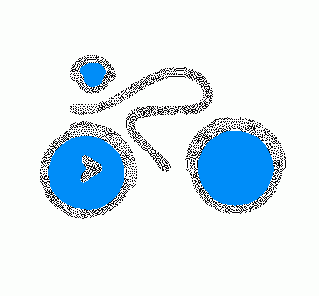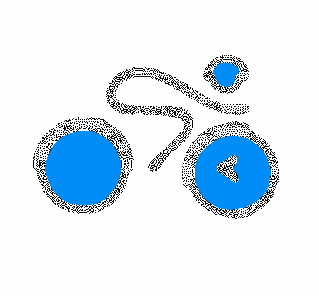| Newsletter - 2012 Archive |
 |
Cycling Club |
 |
| Newsletter - 2012 Archive |
 |
Cycling Club |
 |
Next--->
|
How I Went from Zero to 1200 in Under Three Months This spring I have taken up Randonneur Cycling. I first heard of the discipline when I received a Cycling BC brochure with my mountain bike licence in 1995 and I thought, "That's insane! Why would ANYONE want to ride a bike that far?!?" Well, in the years that followed a serious car/bike collision steered me away from racing and towards cyclo-tourism and it turns out that randonneurring is a great compliment to the trips (X-Canada, Pacific Coast, Maritimes and Newfoundland, Japan, Viet Nam) that I've done along the way. By becoming a randonneur I've challenged myself physically and mentally on a bicycle in new ways AND I've ridden routes in places I'd never have seen otherwise. I've also met a whole new set of friends who share my geekitude for canvas bike luggage, gear ratios and tire width. My tentative foray into this demanding discipline came at BC Randonneurs' 100km [link - pacific populaire] where, despite struggling to keep up with some of the faster riders and jamming my chain so severely that a roadside chain break was required, I was hooked. I decided to join the [link - BC Randonneurs home] and ride as many "Brevets" as possible. A Super Randonneur Series consists of 200, 300, 400 and 600km Brevets approximately every two weeks and I'm proud to report that I came through the [link - Lower Mainland Spring Series] with some [LM Spring Results] good finishing times and a huge smile on my face. It wasn't all fun and games though. There were some, "Learning Experiences" along the way that I'd like to share and thank those I learned them from/with. 1) Don't Waste Time at Controls: One of the reasons I had some decent finish times is that I got in and out of controls quickly. One can waste a lot of time fiddling with luggage or one's bike, eating/drinking too much or yakking with the always helpful and usually chatty (hey, they've been and will be sitting there alone for long stretches) volunteers. 2) When in a pace line or group, don't ride outside your fitness: While trading five minute pulls halfway through the 300 I didn't realize I was trying to end the ride in five minutes, every five minutes until my companion (who has way more experience and better fitness than me) said he'd have to back off the pace. I have to tell you, I was so relieved because I had been silently trying to meet his expectations/pace. 3) Take Care of Your Body or Face the Music: I had a good chuckle when I read in the [link - newsletter 2012-62] that I had, "...absolutely no problem with BC's Toughest 400." 4) Going Slower Can Be More Fun: I did my first 600 as a volunteer pre-ride just one week after the above-mentioned 400. I had a head full of questions about my ability to complete long rides two days in a row--especially on a single week's recovery time. After spending an hour watching Ryder Hesjedal finish strong in the last mountain stage of the Giro in a Hope café and doing an hour of yoga at the top of the Coquihalla, I felt Tony-the-Tiger GrrrrrrREAT! When I mentioned to my riding partners that I was really enjoying riding below the redline for once, one of them said that statements like that are a right of passage for a cyclist and then immediately tried to get my buy in on the helmet mirror concept. Not just yet...but I was able to ride stronger on Sunday and became convinced I could handle a 1200. 5) Good Lights are Needed: At the end of the 400 and all night on the 600 I had to rely more on the generator lights of other riders than I wanted to. I have a Planet Bike 2 watt light on my bike and a Princeton headlight on my helmet and even with both of them going, I can't feel as safe as the generator hub equipped riders I was with. 6) Volunteering is a Rewarding Eye-opening Experience: I'd been awed by the commitment and service of the volunteers as I worked my way through my first Super Randonneur Series but doing the (almost) unsupported pre-ride and volunteering at the finish of the Princeton 600 allowed me to see a different side of the Rando experience. Learning what tired riders look like (death warmed over) and how they behave (comfused small children) gave me a greater appreciation for all the aid I'd received at controls during my first series. Thank you to all past and future volunteers. 7) Ride with People Who Are Better Than You: Riding with more-experienced club mates in the Cascade 1200 (more on this later) greatly enhanced my experience on the ride and accelerated the growth of my Randonneur IQ. I reined myself in and started out the four day journey at a chilled out pace, ate the right foods at the right times, saved a tire that I was changing before it blew off and rode an angled pace line in cross winds for the first time with the help of more-experienced BC Randonneurs. I was also humbled by the power of some of the best Randos in North America on some of the most beautiful roads in the Pacific Northwest. All in all it was a truly unforgettable experience. None of any of these lessons would have been learned without the advice, assistance, long pulls and good humour of the BC Randonneur community. Special Thanks to (in order of appearance): Will Danicek, Peter Stary, Andrew Hartline, Ryan Goldbeck, Colin Fingler, Jamie Guzman, Keith Nichol, Ross Nichol, Bob Goodison, Keith Fraser and Nigel Press. You all made my entry into the wide world of Randonneur Cycling as smooth as it could possibly be. I look forward to seeing you at future rides and controls.
- June 30, 2012 |